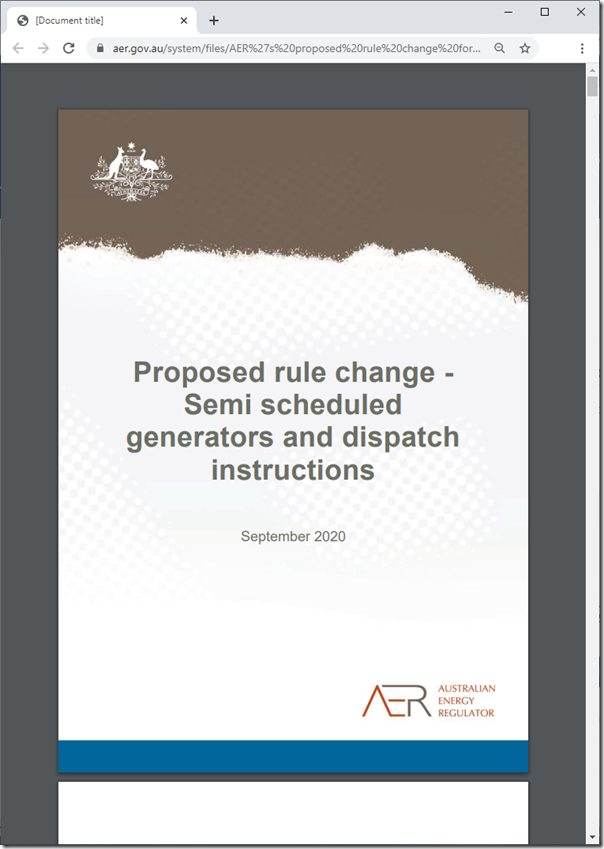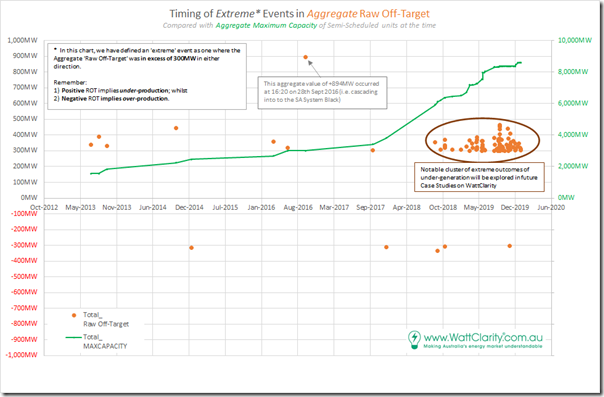On Wednesday 30th September 2020 the AER published this ‘Proposed rule change – Semi scheduled generators and dispatch instructions‘ to conclude their considerations of concerns raised by COAG Energy Council as outlined in this AER Issues Paper published 3 months earlier (on 24th June 2020):
Frequent readers at WattClarity® will understand that we will watch this process with keen interest. It’s over to the AEMC now…
(A) What the proposed rule change covers
As the title suggests, this Rule Change proposal (now submitted to the AEMC) focuses specifically on generators registered as Semi-Scheduled and relates to how they participate in the dispatch process (e.g. bid, and follow dispatch targets).
By definition, then, this precludes consideration of many other stakeholders, including:
1) Generators:
(a) which are registered as Scheduled;
(b) which are registered as Non-Scheduled; and
(c) which are below the registration threshold and so operate invisibly in the NEM.
2) Additionally, Loads are also not considered here:
(a) if they are Scheduled;
(b) if they are not explicitly registered in the NEM and so treated as part of net system load.
The document above is 45 pages long, but the gist of it what’s noted on page 3 of the document in that:
“… the AER has concluded that it is appropriate to:
1) retain the semi scheduled category within the NER and
2) amend the NER to clarify the output of semi scheduled generating units must follow their available resource except during a semi dispatch interval when output should be limited to the cap specified by AEMO.
Specifically, the AER considers that the NER should be amended to clarify that:
1) a dispatch instruction to a semi scheduled generator will be in the form of a megawatt target for the end of the dispatch interval
2) during a non semi dispatch interval the target will be based on the forecast resource availability for the end of the interval
3) semi scheduled generators will be expected to meet this target subject to variations in resource availability
4) during a semi dispatch interval, the generator’s output should be the lower of
(a) the generator’s output cap specified by AEMO and
(b) the generator’s output as determined by its resource availability in that dispatch interval .
The effect of these arrangements is, as far as possible, to retain existing arrangements and flexibility to reflect the variable resource, clarify the intention for semi scheduled generators to fully utilise their available resource unless limited by network conditions or, their offered availability, and restrict the rapid controlled deviations from the resource capability.
(B) More background
Here are:
1) Details of the AER’s consultation process (now completed); and
2) Information published by the AEMC will begin to be collated here (process just beginning, but potentially to be fast-tracked because of prior consultation by the AER).
(C) Our thoughts … thus far
From us here at Global-Roam Pty Ltd (publishers of this WattClarity service) we have already published a number of pieces, including:
1) On Thursday 9th July I published a short piece “‘Too Low for Zero’ as a parable for the AER Issues Paper?” to try to sum up the concern
2) On Friday 17th July, Marcelle posted some thoughts under ‘Semi-scheduled generation – what are the real issues?’ here.
3) On Friday 24th July, I posted more thoughts under ‘Striving to understand the underlying challenges with Semi-Scheduled generators (re AER Issues Paper)’.
4) In a very rare event (but warranted given the broader considerations) we even made a formal submission to the AER here.
… and since that time have been seeking to continue to prepare an growing number of Case Studies looking into a total of 98 discrete instances where aggregate Raw Off-Target across all Semi-Scheduled units was either:
(a) above +300MW (representing collective under-performance) or, much less commonly,
(b) under –300MW (representing collective over-performance relative to AEMO’s expectations, seen in the Dispatch Target).
There was a smattering of only 10 cases through 2013, 2014, 2015, 2016, 2017 and through until August 2018. However thereafter (to the end of 2019) there was a sharp escalation of extreme incidents – as seen in the following chart:
Note also that we have not yet looked into 2020 data, which will be the focus of the GSD2020 (so we can’t comment on whether the trend from 2019 has continued to grow).
————–
Hence we will have more thoughts to share later, as part of the AEMC considerations (and in relation to the broader considerations of ‘NEM 2.0’, which we see as very much interlinked).




Would it be correct to say that over performance is a function of:
– semi-scheduled generators not forced to follow dispatch
– CfD rewarding generators for low wholesale prices
– completely controllable
While underperformance is a function of:
– outage or derating
– unfavourable weather
– largely uncontrollable
Therefore the new rule mostly applies to the over performance situation…